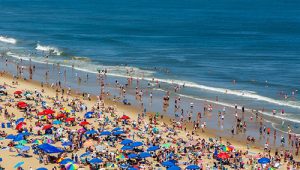
OCEAN CITY — Water rescues performed by the Ocean City Beach Patrol are down substantially this summer.
According to statistics, rescues are at a five-year-low.
Ocean City Beach Patrol Captain Melbourne “Butch” Arbin says Mother Nature is playing a huge factor in driving down what many have perceived to be problematic numbers in recent years.
“It’s been a really hot summer,” said Arbin. “When we have a lot of hot, hot heat, there is little to no wind, and when there is no wind, you have very few waves and that means very few rip currents.”
Nationwide, rip currents make up almost 80 percent of all water rescues, but in Ocean City, Arbin says the number of rip-current related water rescues is significantly higher than the national average.
“It’s probably 95% of our water rescues are rip current related, so when we don’t have very many (rip currents), our numbers go down drastically,” he said.
To date, based on statistics compiled by OCBP through July 24 of this year, there have only been a total of 336 water rescues this summer in Ocean City, which, when compared to the “year-to-date” numbers from previous years, Arbin’s link to lack of weather induced rip currents and distressed swimmers who need to be saved starts to add up. The lowest year-to-date totals, according to Arbin, was 2004 when 270 rescues.
In 2015, there were nearly five times more rescues (1,432) through the first nine weeks of the summer season as there have been this summer thus far. This year’s totals are also well below the five-year average of rescues by the OCBP, which stands at 1,270.
Yet, Arbin says numbers can often be misleading and he has urged the city’s lifeguards to not let their guard down.
“Things can change overnight, and we’ve seen that happen many times over the years, so the public and our lifeguards have to stay focused,” said Arbin. “For instance, on Wednesday this week, we had over 100 rescues.”
Crunching down the numbers could also indicate that the city’s longstanding public messaging to encourage swimmers to only enter the water when the lifeguards are on duty is working too.
“We are seeing fewer rescues before and after our lifeguard shifts and that does indicate that the messaging is working well,” said Arbin. “People are starting to listen, but with this many new people each week, we have to remain vigilant and get that important message across to folks.”
Other statistics measured by the OCBP, such as lost and found, police and ambulance calls, and even beach population is on par with recent years, which makes Arbin point to the weather and the lack of rip currents as the driving force behind the number of rescues plummeting this season.
“If we had usual weather conditions and the stats were down like they are, we could point more to the education, but the facts are showing us that when the rip currents aren’t there, the lifeguards have much less to do,” Arbin said.
The National Weather Service says 20 of the 35 surf-zone fatalities in the United States this summer were due to rip currents. Last year, half of the 84 surf-zone deaths in the United States were caused by people getting caught in rip-currents. In 2014, however, 87% of the more than 100 surf zone deaths were rip current related, according to the NWS.
Additionally, since 2000, males 31-50 have been the demographic most susceptible to rip current related deaths, and 20% of the fatalities were bystanders who entered the water to try and save a distressed swimmer that had been caught in a rip.
“I just want people to remember that weather conditions can change overnight,” said Arbin. “People need to continue to swim only when there’s a lifeguard on duty and to talk with the lifeguard each morning about what to do if they find themselves caught in a rip current. Statistics are just numbers that tell only one part of the story.”
